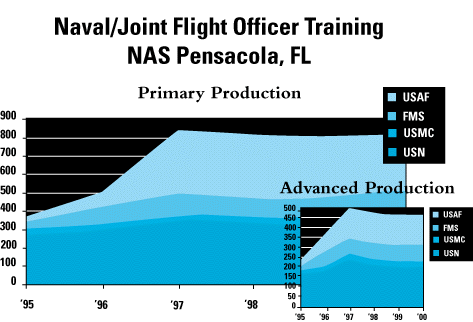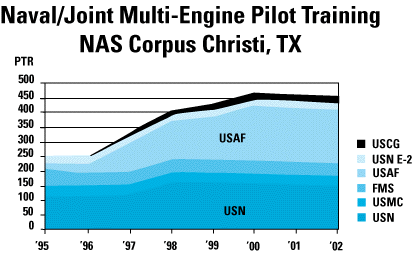AIRCREW TRAINING
A well trained force is the major contributor to readiness. To sustain
readiness today and in the future requires quality people, in sufficient
numbers, with quality training. These elements, when combined with weapon
systems and supported by sound operational doctrine equal operational dominance.
Reduced to its basic form:
(Manpower + Weapon Systems + Doctrine) x Training =
Operational Dominance
The major force multiplier in this overall equation is quality training.
When viewed in relation to potential manpower challenges and reduced defense
budgets, quality training remains the key element which must be sustained
to maintain readiness.
Toward this goal, Naval Aviation has embarked on a training strategy
which applies a systems view to address the three key elements of operational
dominance. This strategy spans the full spectrum of the "Training Continuum"
from aviation accessions through Fleet squadron training. This concept
is captured in the accompanying figure.

To execute this strategy requires a balanced approach which includes:
sufficient numbers of personnel accessed to meet Fleet requirements, quality
training which spans undergraduate/graduate (Training Command through Fleet
Replacement Squadron), and standardized Fleet squadron training. This strategy
is being developed to ensure quality of training while realizing the impacts
of constrained budgets today and in the future.
The major elements of this strategy include:
-
Detailed, quantifiable manpower accession plans to support Fleet requirements.
-
Development of a common Flight Simulator Stategy which provides a common
architecture for new systems and defines a comprehensive plan to upgrade
legacy systems. This plan will emphasize common databases and equipment
where economically and operationally feasible.
-
Application of advanced training system technology to include Computer-Based
Training (CBT), Interactive Course Ware (ICW), and improved flight/tactics
simulators.
-
Integration of this technology into overall Ground-Based Training Systems
(GBTS) such as the advanced undergraduate jet trainer T-45TS (Training
System) and the Joint Primary Air Training System which will replace the
T-34C primary training aircraft.
-
Advancements in ground/sea-based training ranges such as the Joint Tactical
Combat Training System (JTCTS).
-
Full integration of Air Combat Training (ACT) and Operational Risk Management
(ORM) into all phases of the training continuum. These efforts highlight
the impact of safety as an integral part of training.
-
Development of a standardized, aircraft-specific fleet squadron training
program applying the concept of the Air Combat Training Continuum (ACTC).
-
Integration of joint training where it makes sense. Towards this goal the
Navy has taken the lead with the recent integration of all USAF Flight
Officer and advanced turbo-prop pilot training into the Navy training system.
The accompanying figures show the magnitude of this integration.
Naval Aviation has undertaken a proactive training strategy. This strategy
has applied a balanced approach to training, incorporating the right technology
to ensure quality of training while increasing potential efficiencies.
The end goal remains a well-trained force, which ensures READINESS.







